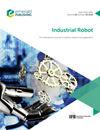Optimization-based hexapod robot locomotion generation
IF 2.5
4区 计算机科学
Q3 ENGINEERING, INDUSTRIAL
Industrial Robot-The International Journal of Robotics Research and Application
Pub Date : 2022-05-24
DOI:10.1108/ir-02-2022-0038
引用次数: 0
Abstract
Purpose The purpose of this paper is specifically to provide a more intelligent locomotion planning method for a hexapod robot based on trajectory optimization, which could reduce the complexity of locomotion design, shorten time of design and generate efficient and accurate motion. Design/methodology/approach The authors generated locomotion for the hexapod robot based on trajectory optimization method and it just need to specify the high-level motion requirements. Here the authors first transcribed the trajectory optimization problem to a nonlinear programming problem, in which the specified motion requirements and the dynamics with complementarity constraints were defined as the constraints, then a nonlinear solver was used to solve. The leg compliance was taken into consideration and the generated motions were deployed on the hexapod robot prototype to prove the utility of the method and, meanwhile, the influence of different environments was considered. Findings The generated motions were deployed on the hexapod robot and the movements were demonstrated very much in line with the planning. The new planning method does not require lots of parameter-tuning work and therefore significantly reduces the cycle for designing a new locomotion. Originality/value A locomotion generation method based on trajectory optimization was constructed for a 12-degree of freedom hexapod robot. The variable stiffness compliance of legs was considered to improve the accuracy of locomotion generation. And also, different from some simulation work before, the authors have designed the locomotion in three cases and constructed field tests to demonstrate its utility.基于优化的六足机器人运动生成
本文的目的是为六足机器人提供一种基于轨迹优化的更智能的运动规划方法,以降低运动设计的复杂性,缩短设计时间,生成高效准确的运动。设计/方法/方法基于轨迹优化方法生成六足机器人的运动,只需指定高级运动要求。本文首先将轨迹优化问题转化为一个非线性规划问题,将运动要求和具有互补约束的动力学定义为约束条件,然后利用非线性求解器进行求解。考虑腿的柔度,将生成的运动部署到六足机器人样机上,验证了该方法的实用性,同时考虑了不同环境的影响。结果生成的运动被部署在六足机器人上,并且运动与规划非常一致。新的规划方法不需要大量的参数调整工作,因此大大缩短了设计新运动的周期。提出了一种基于轨迹优化的12自由度六足机器人运动生成方法。考虑了腿的可变刚度顺应性,提高了运动生成的精度。此外,不同于以往的一些仿真工作,作者设计了三种情况下的运动,并进行了现场试验,以证明其实用性。
本文章由计算机程序翻译,如有差异,请以英文原文为准。
求助全文
约1分钟内获得全文
求助全文
来源期刊
CiteScore
4.50
自引率
16.70%
发文量
86
审稿时长
5.7 months
期刊介绍:
Industrial Robot publishes peer reviewed research articles, technology reviews and specially commissioned case studies. Each issue includes high quality content covering all aspects of robotic technology, and reflecting the most interesting and strategically important research and development activities from around the world.
The journal’s policy of not publishing work that has only been tested in simulation means that only the very best and most practical research articles are included. This ensures that the material that is published has real relevance and value for commercial manufacturing and research organizations. Industrial Robot''s coverage includes, but is not restricted to:
Automatic assembly
Flexible manufacturing
Programming optimisation
Simulation and offline programming
Service robots
Autonomous robots
Swarm intelligence
Humanoid robots
Prosthetics and exoskeletons
Machine intelligence
Military robots
Underwater and aerial robots
Cooperative robots
Flexible grippers and tactile sensing
Robot vision
Teleoperation
Mobile robots
Search and rescue robots
Robot welding
Collision avoidance
Robotic machining
Surgical robots
Call for Papers 2020
AI for Autonomous Unmanned Systems
Agricultural Robot
Brain-Computer Interfaces for Human-Robot Interaction
Cooperative Robots
Robots for Environmental Monitoring
Rehabilitation Robots
Wearable Robotics/Exoskeletons.

 求助内容:
求助内容: 应助结果提醒方式:
应助结果提醒方式:


